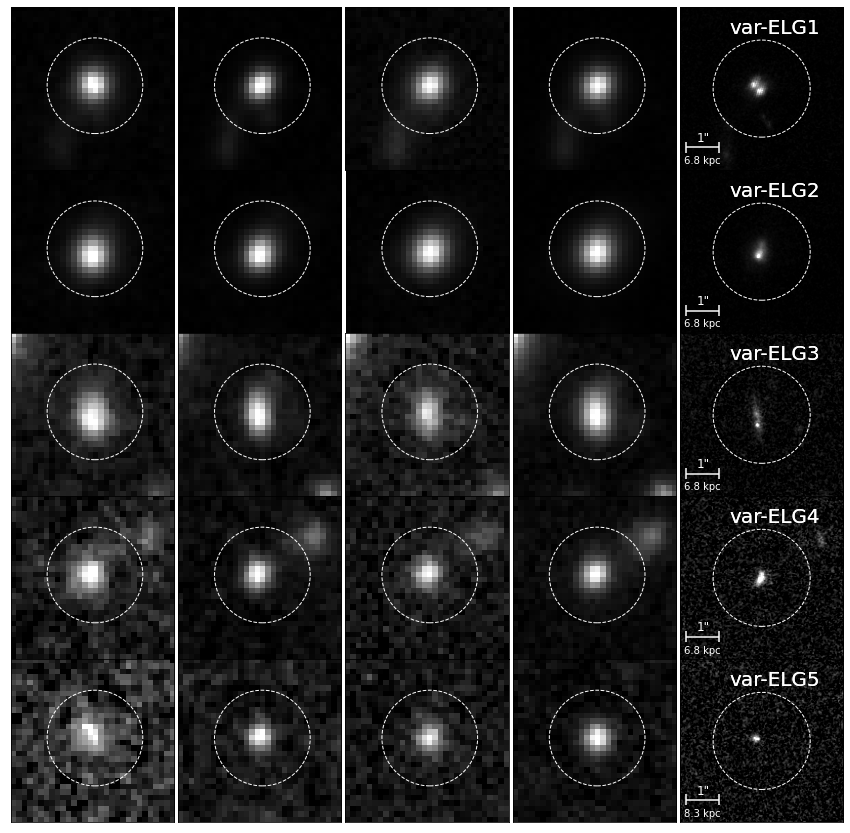Astronomers probed the origin of optical variability of low-redshift emission-line galaxies
Recently, astronomers from the Shanghai Astronomical Observatory of the Chinese Academy of Sciences used a sample of emission line galaxies in the COSMOS field with two-epoch narrowband imaging separated by 12 years to study their optical variability. Only a small fraction of galaxies was found showing optical variability. Such variability is unlikely to be caused by the activity of the central supermassive black holes, but more likely to be caused by the activity of star formation such as supernova explosion. This work has been published in The Astrophysical Journal on November 17th.
Emission-line galaxies are relatively low-mass, have less dust, and are efficiently star-forming galaxies generally regarded as abundant in the early universe. These are also confirmed by the first data of Webb Space Telescope (JWST)[1]. Nebular lines such as Hα can trace the star formation rate of galaxies, so emission line galaxies are widely used to study star formation and galaxy evolution of galaxies across the cosmic time, and to reveal the star formation history of the universe. However, there is still a lack of systematic probes on the optical variability of such galaxies. For example, why such galaxies show variability and what fraction of these galaxies show variability, are still unclear.
The team of this work includes astronomers from SHAO, University of Science and Technology of China, Yunnan Observatories, and Polar Research Institute of China. They investigated the optical variability of a sample of emission-line galaxies. They used the narrow-band imaging data obtained from the ground-based 8-meter Subaru telescope in the COSMOS field, separated by 12 years, to check the narrow-band photometric variation of a sample of emission line galaxies. After excluding the effect caused by the different narrowband filters' shapes, they found that less than 3% of the galaxy samples had significant optical variability. The optical, X-ray, infrared, and radio data of this sample are further analyzed. They then excluded the existence of active central supermassive black holes in this sample.
"During the evolution of galaxies, there are three possible origins of optical variability: accretion of the central black hole, the explosion of supernovae during active star formation, and the stellar tidal disruption event. However, we find that active galactic nuclei are not the main contributors to the optical variability in these emission-line galaxies. Moreover, the high-resolution images with HST revealed their merging morphology (Fig. 1)." said Ruqiu Lin, a Ph.D. student of the Shanghai Astronomical Observatory and the first author of the paper. "The star formation is enhanced in the merging galaxies, and thus we would see more active star formation activities such as supernova explosions. Hence, the variability in low redshift emission-line galaxies may be related to the star formation activity during the merging process."
Zhenya Zheng, a professor of the Shanghai Astronomical Observatory and the corresponding author of the paper, explained: "Previous works used emission line galaxies as a static tool to study the star formation history of the universe. Right now, with the enrichment of astronomical surveys, we can systematically check the optical variability of such samples in a perspective of a dynamic universe. Furthermore, we know that galaxies in the early universe are more active in star formation, but it is very difficult to be observed directly. Therefore, studying their analogs in the low-redshift universe will improve our understanding of galaxy formation and evolution in the early universe. "
Fig.1 Images cutouts of five variable ELGs. From left to right are SC-NB816, SC-i', HSC-NB816, HSC-i, and HSC/ACS-i band images, respectively.
This project was supported by the National Natural Science Foundation of China, the Natural Science Foundation of Shanghai, the CAS PIFI Program, and the China Space Station Telescope Program.
Paper links:
Reference:
[1] Schaerer, D., Marques-Chaves, R., Barrufet, L., et al. 2022, Astronomy and Astrophysics, 665, L4. doi:10.1051/0004-6361/202244556
Contacts:
Ruqiu Lin, linruqiu@shao.ac.cn
Zhen-Ya Zheng, zhengzy@shao.ac.cn
